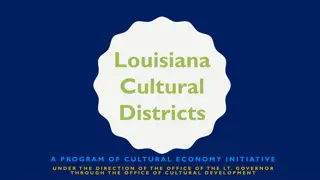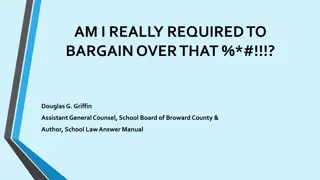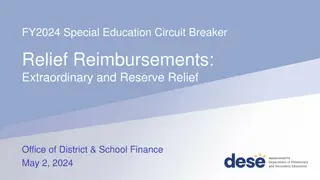Massachusetts District and School Accountability System Fall 2023
The Massachusetts District and School Accountability System for Fall 2023 includes various components such as Accountability Indicators, Normative Component, Criterion-Referenced Component, Assessment Participation, Categorization of Schools and Districts, and Reporting. It emphasizes measuring the
2 views • 32 slides
Special Education Circuit Breaker Program Overview FY2024
The Special Education Circuit Breaker Program for FY2024 provides financial assistance to public school districts for high-cost special education services. The program includes Relief Claims and Year-End Claims cycles, with legal references for reimbursement guidelines. Reserve Relief funds are avai
1 views • 27 slides
Understanding NJQSAC District Performance Review Indicators
NJQSAC requires public school districts in New Jersey to complete a District Performance Review (DPR) comprising self-assessment tools measuring compliance with quality performance indicators in areas like instruction, fiscal management, governance, operations, and personnel. The District NJQSAC Com
0 views • 37 slides
Annual ST-3 Training for School Districts - GASB 96 Updates Fall 2023
This training program covers GASB 96 updates, General Fund Transfers, NRT updates, BOCES Expenditure Reporting, and filing ST-3 for school districts. GASB 96 focuses on Subscription-Based Information Technology Arrangements (SBITA), defining short-term and long-term contracts and how to account for
1 views • 76 slides
Division 22 Standards Assurances for the 2022-23 School Year Overview
The Division 22 Standards Assurances outline the requirements that Oregon school districts must meet to be considered standard. These standards cover various areas such as instructional time, state assessments, human sexuality education, counseling, student identification, credit options, suicide pr
0 views • 20 slides
Identifying Student Percentage Reporting SY 2021 - 2022
Identified Student Percentage Reporting (ISP) is essential for districts to report the number of students identified through direct certification and categorical lists in eSchool. This report must be submitted by April 15, 2022, to comply with federal regulations. Understanding how ISP is calculated
1 views • 12 slides
Understanding NJQSAC District Performance Review Indicators
The NJQSAC District Performance Review (DPR) is a comprehensive process that assesses public school districts in five key areas: Instruction and Program, Fiscal Management, Governance, Operations, and Personnel. Districts must complete a self-assessment tool to measure compliance with quality perfor
0 views • 41 slides
Understanding Municipal Management Districts (MMDs) in Texas
Municipal Management Districts (MMDs) in Texas are special districts that are self-governed but require approval from the host municipality. They have the authority to provide infrastructure and approved service plans. MMDs can issue tax-exempt bonds, levy taxes, assessments, and impact fees, and pr
7 views • 21 slides
NJQSAC User Manual Overview and Process
The New Jersey Quality Single Accountability Continuum (NJQSAC) User Manual provides detailed information on the evaluation process initiated by county offices of education for school districts. It outlines the background, purpose, and goals of the NJQSAC, focusing on improving consistency, increasi
0 views • 11 slides
School Calendars and Comparative Analysis for St. Louis Public Schools 2014-2015
Executive Director Deanna Anderson presented the 2014-15 school calendar, compared calendars from other districts, and sought public input. Meetings with staff and analysis of surrounding districts were conducted to finalize the academic schedule. Key dates from various school districts were outline
0 views • 8 slides
Louisiana Cultural Districts: Engaging Communities in Cultural Development
The Louisiana Cultural Districts program, under the Cultural Economy Initiative, aims to revitalize local communities by creating hubs of cultural activity. By building on cultural resources and promoting art and culture, the program benefits from increased occupancy, commerce, and community identit
2 views • 18 slides
Overview of SAPSASA Hockey Current State and Districts for Boys and Girls in 2015
SAPSASA Hockey in 2015 discussed the current state of the game, with detailed information on districts, teams, and age groups. It highlighted the need for growth and sustainability through collaboration with clubs and organizations. The document also outlined specific districts for boys and girls, e
0 views • 8 slides
Rural CCMR Accelerator Program Overview
The Texas Impact Network (TIN) is launching a program to support rural school districts in Texas with resources to improve college, career, and military-readiness outcomes for high school students. The program consists of two phases, with the first phase focusing on strategic planning and the second
0 views • 21 slides
Real World Learning Workbook for School Districts
This workbook is designed to assist leadership teams in creating an action plan to implement and enhance real-world learning in their school districts. It involves self-assessment, reflection, and action plan development. The vision, considerations, and action items for real-world learning are explo
0 views • 25 slides
Rural Education Achievement Programs: SRSA and RLIS Introduction
The Rural Education Achievement Programs, including the Small, Rural School Achievement Program (SRSA) and the Rural and Low-Income School Program (RLIS), aim to meet the unique needs of rural school districts by providing grants for those lacking resources to compete for federal grants, and for dis
0 views • 12 slides
Understanding OPEB Requirements and Accounting in School Finance
OPEB, or Other Postemployment Benefits, are benefits received by retired employees earned during their careers. GASB Statements 45, 74, and 75 provide guidelines for reporting and accounting for OPEB in school districts. Compliance with GASB 75 is mandatory for all districts to determine OPEB liabil
0 views • 35 slides
Special Districts in the Northeast United States: Enhancing or Hindering Local Government Service Delivery?
Special districts in the Northeast US, independent units of local government, professionalize public service management. They have specialized functions, administrative and financial independence, and low political visibility. The study aims to develop a typology of multi-purpose special districts f
0 views • 12 slides
Special Fire District Performance Reviews Overview
Presentation on the OPPAGA Fire District Reviews detailing statutory requirements, research objectives, findings for individual districts, and recommendations for special fire control districts in rural areas. The performance reviews cover governance, service delivery, resource management, and more,
0 views • 34 slides
Wellborn Zoning Districts Focus Group Meeting
Wellborn Zoning Districts Focus Group Meeting involves planning and development services led by Jessica Bullock, Staff Planner. The districts discussed include Wellborn Estate and Wellborn Restricted Suburban, each with specific purpose statements and dimensional standards. Wellborn Estate focuses o
0 views • 11 slides
Understanding the Truth about Districts and Homeownership Risks
Debunking common misconceptions about districts, this discussion sheds light on the limited obligations and protections for homeowners. It explains how districts provide financial viability and transparency, showcasing the intelligence of homeowners in evaluating their choices.
0 views • 11 slides
Understanding Active vs Primary Status in Education System of British Columbia
In the education system of British Columbia, students classified as Active no Primary are those who are no longer active in their Primary School (School of Record) but are active in a Secondary School. This status affects reporting, tracking, and school record maintenance. Schools and Districts have
0 views • 8 slides
Impact of Cyber/Charter Costs on School Budgets Over 10 Years
The 10-year history of SASD Cyber/Charter Costs reveals a significant increase, with total charter school tuition payments exceeding $2.0 billion in 2018-19 alone. This amount could cover the salaries of 29,700 teachers and surpasses spending on career and technical education programs. The costs ass
0 views • 8 slides
Understanding Collective Bargaining in School Districts
Collective bargaining in school districts involves negotiating over mandatory and permissive subjects such as wages, hours, and conditions of employment. School districts must differentiate between mandatory and permissive subjects, and disputes over mandatory subjects must be resolved through impas
0 views • 29 slides
Addressing Local Wealth Disparities in Ohio's School Funding
School districts in Ohio experience significant variations in property values, affecting their ability to generate local revenue. The state's school funding formula aims to neutralize the impact of local property wealth on educational opportunities by providing more aid to lower-wealth districts. Th
0 views • 5 slides
Enhancing Coordination Between School Districts and Out-of-School Time Programs
Explore the collaboration efforts between school districts and out-of-school time programs, focusing on Massachusetts's Test & Stay Program, which enables asymptomatic students to stay in school buildings while managing COVID-19 exposure risks. Learn about the Department of Elementary and Secondary
0 views • 16 slides
FY2024 Special Education Circuit Breaker Relief Reimbursements
Circuit Breaker Program provides financial assistance to public school districts for high-cost special education services, with relief claims reimbursed for current year expenses and year-end claims reimbursed for prior year expenses. Reserve Relief supports districts with significant instructional
0 views • 13 slides
Understanding Fund Accounting in School Districts
Explore the world of fund accounting in school districts through an in-depth look at different fund types, their definitions, and the regulations governing them. Learn about the unique characteristics of instructional funds, debt service funds, capital projects funds, food and community service fund
0 views • 36 slides
Understanding Transfer of Service (TOS) in Wisconsin School Districts
Transfer of Service (TOS) in Wisconsin school districts involves the transfer of financial responsibility from a local municipality to a school district, allowing for exemptions to revenue limits. Eligibility requirements include being within the application timeline and having students come from ot
0 views • 36 slides
Teacher Salary Comparison in Fayette County vs. Jessamine County School Districts
This slide provides a comparison of teacher salaries in Fayette County and Jessamine County School Districts for different education levels and years of experience. It highlights the differences in pay scales between the two districts, showcasing the earning potential for teachers at various stages
0 views • 4 slides
Housing Initiatives in Texas School Districts
Several Texas school districts have implemented workforce housing initiatives to provide affordable housing options for teachers and staff. Initiatives include property ownership, rental units, and partnerships with housing finance corporations. Examples include Ector County ISD's housing for teache
0 views • 13 slides
Montana School Funding Equalization Mechanisms Overview
Montana's Property Tax Advisory Council's Education Subcommittee explains the Guaranteed Tax Base (GTB) and School Equalization and Property Tax Reduction (SEPTR) mechanisms that aim to equalize revenue-generating capacity among school districts. GTB aid subsidies are provided to districts with less
0 views • 13 slides
Regional Special Education Transportation (RSET) Program Overview
RSET, which stands for Regional Special Education Transportation, is an initiative developed by ACES to help districts save money while safely transporting students to out-of-district placement sites. The program benefits districts by reducing transportation costs, addressing parent concerns, and ma
0 views • 13 slides
Oregon HB 3499 Implementation Public Comments
Public comments provide feedback on the implementation of HB 3499 in Oregon, focusing on the rules and improvements needed for English Language Learners (ELL) at the district and school levels. Suggestions include more details with flexibility, accountability for ELL improvement, addressing concerns
0 views • 11 slides
Analysis of EL Numbers in Oregon Schools and Districts
This analysis, presented during the HB 3499 ELL Program Advisory Group Meeting, highlights the distribution of Oregon districts and schools based on the number of current English Learners (ELs). It emphasizes the importance of considering EL numbers in identifying low-performing institutions and dis
0 views • 4 slides
Hotel Tax Distribution Overview for House Oversight Subcommittee
Hotel Tax Distribution presentation covers changes in hotel tax distribution, including how it is distributed, what is taxed, and the shared regional districts in Rhode Island. It details the breakdown of occupancy taxes, state funds distribution, and the impact on various municipalities and tourism
0 views • 17 slides
Understanding the Minnesota School Food Buying Group (MSFBG)
Discover how the Minnesota School Food Buying Group (MSFBG) helps school districts save money through joint purchasing agreements, its history, goals, and impact over the years. Learn about its award process, cost-saving opportunities, and current participating districts and distributors.
0 views • 25 slides
Comprehensive Overview of Colorado Springs Special Districts Work Sessions
Delve into the detailed sessions held by the Colorado Springs Special Districts on various topics including district accountability, transition of governance, dissolution, and more. Learn about the progression from prior sessions to the latest updates on mill levies, taxable status, and property ass
0 views • 19 slides
Federal Programs for Limited English Proficient (LEP) Immigrant Children and Youth
This document outlines the procedures and requirements for subgranting funds under Title III-A for Limited English Proficient (LEP) immigrant children and youth. It covers subgranting procedures, allowable expenditures, claiming reimbursement procedures, and annual reporting guidelines. Districts mu
0 views • 25 slides
Alternative Certification Program for School Districts in West Virginia
West Virginia Association of School Human Resource Officials discussed the implementation of Alternative Certification (AC) programs for school districts facing critical teacher shortages. The process involves applying for an Alternative Teaching Certificate, commitment to program requirements, and
0 views • 23 slides
Introduction to Partnership Agreement Fundamentals in Districts - Webinar on December 14, 2022
In this webinar, explore the key components of partnership agreements within districts. The Office of Partnership Districts introduces liaisons and outlines support levels, roles, and expectations. The model and coverage areas, including benchmarks and outcomes, are discussed. Additionally, details
0 views • 48 slides







































